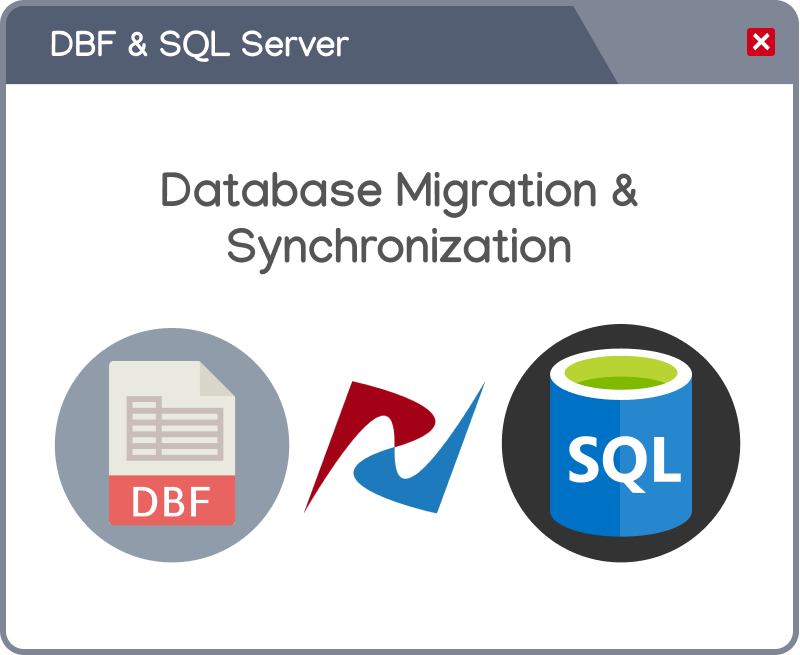Simplifying Data Migration: Converting DBF to SQL Server.

Introduction.
In the ever-evolving world of data management, businesses often face the challenge of migrating their data from legacy systems to more modern and scalable platforms. One such migration scenario involves converting DBF to SQL Server, commonly associated with dBase, XBase, Clipper, FoxBase and FoxPro databases.
This article explores the process of DBF to SQL Server database migration, highlighting the benefits and providing insights into best practices for a seamless transition.
Understanding the Need for Migration.
As technology progresses, legacy systems like FoxPro may no longer meet the demands of modern businesses. On the other hand, SQL Server offers a robust and feature-rich environment that can handle large volumes of data, provides enhanced security measures, and supports high-performance transactional applications. Migrating from DBF to SQL Server ensures longevity, scalability, and compatibility with current and future data management needs.
Benefits of Migrating to SQL Server.
1. Scalability: SQL Server offers scalability options to accommodate growing data volumes and user demands, ensuring your system can handle future growth.
2. Performance: SQL Server's optimized query processing and indexing capabilities enable faster and more efficient data retrieval, enhancing application performance.
3. Security: SQL Server provides robust security features, including encryption, user access controls, and data masking, protecting your valuable data from unauthorized access.
4. Integration: SQL Server seamlessly integrates with other Microsoft products, facilitating integration with business intelligence tools, reporting services, and analytical platforms.
Choosing the Right Conversion Tool.
Selecting a reliable and efficient conversion tool is crucial to simplify the DBF to SQL Server conversion process. DBConvert/ DBSync for FoxPro and MSSQL software streamlines the migration process, providing a powerful and user-friendly solution. It offers comprehensive features, including intuitive user interfaces and efficient data mapping capabilities.
Step-by-Step Conversion Process.
1. Assess Your DBF Files: Begin by analyzing the structure and content of your DBF files. Understand the relationships, data types, and any specific requirements for the migration process.
2. Prepare the SQL Server Database: Create a new database or identify an existing one to serve as the target for your migrated data. Ensure that the SQL Server instance is configured correctly and accessible.
3. Install and Configure the Data Migration Tool: Install the appropriate software, either DBConvert or DBSync, based on your specific task, whether conversion or synchronization. Proceed to configure the basic settings, including establishing connections for the source and target databases.
4. Map the Data: In this crucial step, you must define the mapping between the fields in your DBF files and the corresponding columns in the SQL Server table. It is essential to consider data types, indices, and constraints to ensure a precise and efficient data transfer.
If you're using the DBConvert software, you'll be pleased to know that it automates the mapping process, making it a seamless experience. The software intelligently analyzes the structures of the DBF tables and SQL Server tables and automatically establishes the mappings. However, if you desire further customization, the software also allows you to adjust the mappings according to your specific requirements manually. This flexibility will enable you to tailor the data mapping to meet your unique needs, ensuring a highly personalized data migration process.
5. Execute the Conversion/ Synchronization: Start the data migration process and monitor its progress. The tool should provide real-time feedback, allowing you to track potential errors or issues requiring attention.
6. Verify and Validate: After the conversion, thoroughly verify the migrated data in the SQL Server database. Perform data integrity checks, validate relationships, and ensure data is accurately represented.
Synchronization.
Synchronizing data between DBF files and SQL Server databases can be challenging due to the differences in their underlying technologies and structures. However, DBSync tool from DBConvert provides a reliable solution to streamline the synchronization process and ensure data consistency across these disparate systems.
Legacy FoxPro databases often serve as the backbone of critical applications in many organizations. However, as businesses evolve, there is a growing need to integrate these legacy systems with modern SQL Server databases to leverage advanced features, scalability, and improved data management capabilities.
DBSync handles the complexities of data mapping and transformation between DBF and SQL Server. It intelligently detects and resolves conflicts that may arise during the synchronization process, ensuring data integrity and minimizing the risk of data inconsistencies. This intelligent synchronizer mechanism considers each database platform's specific characteristics and provides accurate data replication.
With DBSync, organizations can schedule automated synchronization tasks to run at predefined intervals. This feature eliminates manual intervention and ensures data remains synchronized without constant monitoring. Additionally, the software provides detailed logs and reports to track the synchronization process, allowing for easy troubleshooting and auditing.
The user-friendly interface of DBSync simplifies the configuration and management of synchronization tasks. It guides users through the process with a wizard-like interface, making it easy to set up connections to both the DBF tables and the SQL Server database. Users can define the mapping between tables, specify synchronization options, and customize the synchronization process to meet their requirements.
Conclusion:
Migrating DBF tables to SQL Server allows businesses to modernize their data management systems, unlock advanced features, and ensure long-term scalability. By following a well-defined conversion process and utilizing reliable tools like DBConvert/DBSync, businesses can seamlessly transition their data from DBF files to the robust SQL Server platform. Embracing this migration not only future-proofs data management practices but also enables organizations to leverage the full potential of their data in an ever-evolving digital landscape.
